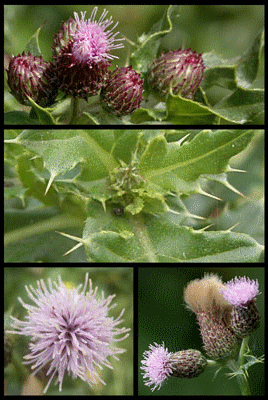 Canada Thistle
Canada Thistle
Noxious Weeds: Less Common: Canada Thistle and Specific Controls
Description
Canada Thistle · Cirsium arvense (L.) · is a colony-forming perennial. Not native to North America, it was introduced in the late 18th Century from Eurasia. It is most often found in cultivated fields, pastures, and waste places.
Vegetative Characteristics
A mature Canada Thistle plant is 2 to 5 feet tall, branching at the top. The leaves are 4 to 8 inches long, usually dark green with spiny serrated edges. Buds are pea size, flowers are 3/4 of an in inch or less in diameter and purple to rose in color.
Reproductive Characteristics
Canada Thistle reproduces by seeds and roots. Male and female flowers are produced on separate plants. Consequently, individual plants (and in some instances entire patches) may be seedless. Seeds are dark brown and only 1/8 inch long. Roots are abundant, deep and creeping, forming a dense patch much the same as bindweed.
Specific Controls·
Methods of Control Timely herbicide application is the best method to control Canada Thistle. Approved chemicals for control are:
Notably Counter-Productive Methods
Factors for Best Control
Description
Canada Thistle · Cirsium arvense (L.) · is a colony-forming perennial. Not native to North America, it was introduced in the late 18th Century from Eurasia. It is most often found in cultivated fields, pastures, and waste places.
Vegetative Characteristics
A mature Canada Thistle plant is 2 to 5 feet tall, branching at the top. The leaves are 4 to 8 inches long, usually dark green with spiny serrated edges. Buds are pea size, flowers are 3/4 of an in inch or less in diameter and purple to rose in color.
Reproductive Characteristics
Canada Thistle reproduces by seeds and roots. Male and female flowers are produced on separate plants. Consequently, individual plants (and in some instances entire patches) may be seedless. Seeds are dark brown and only 1/8 inch long. Roots are abundant, deep and creeping, forming a dense patch much the same as bindweed.
Specific Controls·
Methods of Control Timely herbicide application is the best method to control Canada Thistle. Approved chemicals for control are:
- 2,4-D
- Tordon
- Banvel
- Telar
Notably Counter-Productive Methods
- Cultivation is not an effective method of control.
- Chopping up the roots only increases the plant population.
Factors for Best Control
- Early identification and herbicide applications in the rosette stage are most effective.
- For ground application, apply herbicides in 10 to 20 gallons of water per acre.
- Repeat applications may be necessary to prevent seed production and reduce infestations.